17.01.2005
Mark DVORETSKY. EXCHANGE OF QUEENS. Part 1.
I haven't made any statistical analysis, but I think I won't be mistaken stating that at least in the half of games of any chess player there were exchanged queens. At times such an exchange is natural and doesn't invite questions, but in many cases a chess player has to solve an unobvious problem: who will benefit from an exchange, and if the exchange is advantageous, then how to get it and how to carry it out.
It's clear that such a profound transformation of a position as an exchange of the strongest piece pulls ropes. It is useful to practice this important method, the proposed wide-ranged selection of examples will be of help. Almost all the positions are exercises, mainly they are not difficult (you will recognize an exercise by a question-mark under a diagram with indication of move order). I recommend you to try to find a solution on your own before reading the text of exercises.
There are no absolute laws and rules without exceptions in chess. The interpretations of the same problem can be antipodal – compare, for example, two well-known formulas: "No exchange with the weak!" and "To the ending with young generation! ». However there are many instances, when a chess player, having added to his armoury one or another formula, sometimes even unsuccessful, follows it inviolately without taking particular circumstances into account.
For example some people are sure that they should act simpler, exchange pieces playing against the opponents that surpass in class – thus there are more chances to get a desired draw.
I'll cite a situation, described in the book by Dvoretsky and Yusupov "Methods of chess training".
In the summer of 1991 I was coaching young American chess players. To my surprise I discovered that many of them when playing important games or playing against more eminent opponent, don't want to be active, they think only about a draw. It's clear that the result is quite the opposite – an extremely prudent, passive play most often makes a position worse.
Michael Grann – Dvoretsky
Blitz game 1991
1.е4 g6 2.d4 Ґg7 3.¤с3 с6 4.f4 d6 5.¤f3 Ґg4 6.Ґе3 Јb6 7.Јd2 ¤d7?. I forgot toexchangeon f3 beforehand, and the whole structure of Black became senseless at once.
8.Ґе2 Ја5 9.0-0 b5
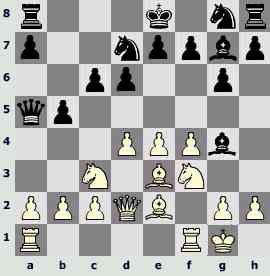
Black doesn't develop the knight on f6, being afraid of е4-е5. But a pawn attack at the queen side with white king that has made a long castling has no prospects. Having played 10.h3, my opponent could easily emphasize his great development advantage. Instead Michael made an absurd exchange.
10.¤g5?! Ґ:е2 11.¤:е2? Ј:d2(thanks!) 12.Ґ:d2 h6 13.¤f3 ¤gf6(now it's possible to develop the knight) 14.е5 ¤d5. Black has an acceptable position; later on he wins the ending.
– What for did you exchange the queens? – I asked my opponent.
– I didn't know how to play.
– Any way you like, but only with queens! White has an excellent chance to attack.
Generally Michael is a chess player of a fighting, active stile, but in this case we can see a widespread reflex (which is absolutely wrong) – striving for playing quite and "more sure" against the stronger opponent. In fact such an approach is in opponent's favour and usually facilitates the execution of his task.
Such incidents take place quite often not only with American schoolchildren. Quite recently I was looking through my student Inarkiev games, that were played in the autumn of 2004 at the Cup of European clubs in Turkey, where Ernesto playing for the team of Tomsk, scored 6 points out of 7. It amused me that in the first three rounds his opponents made the same mistake, they suggested themselves a transition into the disadvantageous for them ending.
Ristoja – Inarkiev
Izmir 2004
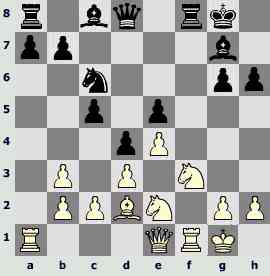
1.
Black controls more space in the centre and at the queen side. A certain pressure of White on the position of the opponent's king can serve as compensation. 16.Јg3 ўh7 suggested itself and now either 17.h3 with subsequent ¤h2-g4 or 17.h4, planning not only to fulfill the transition of the knight on g4, but also to play h4-h5 on occasion. It seems to me, that chances of the parts are approximately equal.
In the game White quite groundlessly suggested the exchange of queens, thereby having saved the opponent from troubles at the queen side and freed his hands at the opposite part of the board.
16.Јh4? Ј:h4 17.¤:h4 Ґg4! 18.¤g3 ўh7 19.h3 Ґe6 20.¤f3 ўg8!. A good preventive move. Having played h3-h4-h5, White planned to gain squares for a knight that stands idle on g3. Now to 21.h4 there are 21...h5 22.¤g5 Ґg4.
However White should have played this way (the square g5 could have been of use later), or, according to the "principle of the worst piece" (see the lecture of Alexei Kosikov from the book by Dvoretsky and Yusupov "Positional playing"), should have moved the badly situated knight g3 along h1-f2-g4. For some reason White moved there another knight that was quite well situated on f3.
21.¤h2 a5 22.¤g4 ўh7 23.¦:f8 ¦:f8 24.¦f1 ¦:f1+ 25.ў:f1 ¤b4 26.Ґ:b4 cb. Pawns advanceat the queen side, supported by two strong bishops, quickly leads to the aim.
27.ўe1 b5 28.¤e2 ўg8 29.¤h2 h5 30.ўd1 (30.¤f3 is more stubborn) 30...ўf7 31.¤f3 ўf6. White resigned.
Inarkiev – Schebler
Izmir 2004

1...
Black kept an acceptable position in the middlegame after 19...¤e6 20.¦c4 Јe8. Perhaps 19...b5! 20.ўb1 are more accurate, and only now 20...¤e6 or 20...¦b8!?.
19...Јe6? 20.Ј:e6 ¤:e6 21.¦d7. In the ending White has a better position, his pieces are more active, and in case of subsequent exchanges the white king will quicker enter the play.
21...¦fc8 (21...¦fd8!?) 22.ўb1 ¤c5 23.¦7d5 ўf8 24.¤b5 g6?!
24...a6 should be chosen, since 25.¤d6 ¦c6 26.¤c4 ¦ac8 are not dangerous. 25.¤c3 is also met by 25...¦c6І.
25.h4 (a provocative move) 25...h5?. The provocation succeeded! Usually it's efficient to prevent the opponent's pawns advance this way, but in this case the move g2-g4 isn't preventive, but on the contrary it wins in force, because it leads to the creation of the passed pawn on the line "h".
26.g4! hg 27.fg a6 (or 27...ўg7!? 28.¤d6 ¦c7 29.h5±) 28.¤d6 ¦c6 29.h5 ¦d8? (29...ўg8 is more stubborn) 30.h6 f6 31.h7. Black resigned.
Rotstein – Inarkiev
Izmir 2004
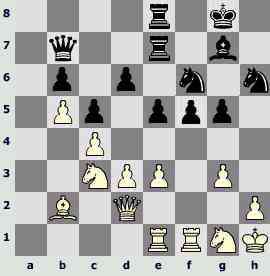
1.
For a long time the chess players were artfully keeping up the tension in the difficult for estimation situation, and at last White lost self-control.
33.Јg2?. It was necessary 33.e4›.
33...Ј:g2+ 34.ў:g2 e4!. Now the position of White falls to pieces. To 35.d4 come 35...cd 36.ed ¦c7.
35.¤a4 ¦a7! 36.Ґ:f6 (36.¤:b6 ¦a2) 36...¦:a4 37.Ґ:g5 ed 38.Ґ:h6 Ґ:h6 39.¦:f5 ¦:e3 40.¦ef1 d2 41.¦d5 ¦e1 (41...¦a2! 42.¦f2 ¦e1) 42.¤f3 ¦a2, and Black won easily.
After a little introduction let's turn to a systematic examination of episodes on the subject of "exchange of queens". The whole selection is divided into several subsections. The division is certainly rather relative, since many positions could be placed also in other rubrics.
FORCINGOFAPLAY
Frequently the decision about the exchange of queens concerns not positional, but purely tactical peculiarities of the situation: just in that way the play can be switched onto the track of a favourable for us tactical variant.
Ebert – Portisch
Interzonal tournament, Rio de Janeiro 1979

1...?
43. . . . Јc5-d4!
Exchange of queens leads to win of material or a break-through of the passed pawn into a queen.
44.Јd3:d4
There was 44.Јe2 Ґ:e4+ 45.ўf1 Ґf5 in the game. White resigned.
44. . . . e5:d4
45.ўg2-f3 d4-d3!
Certainly, not 45...Ґ:a4? 46.ba d3 47.ўe3!ќ.
46.c2:d3 Ґc6:a4°
Georgi – Mich.Tseitlin
Balatonberen 1989
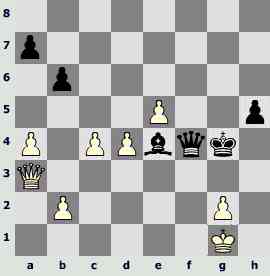
1...?
45. . . . Јf4-g3!°
In the ending Black checkmates or queens a pawn.
46.Ј:g3+ ў:g3 47.e6 (47.ўf1 Ґ:g2+ 48.ўe2 h4 49.e6 h3) 47...Ґ:g2 48.e7 (48.d5 h4 49.e7 h3) 48...Ґc6 49.b4 h4 50.d5 Ґe8.White resigned.
Karpov – J.Polgar
Linares 1994

1.?
18.Јc5:b6! a7:b6
19.Ґa3-c5!
White wins a pawn: 19...¦:a1 (19...¦b8 20.Ґ:b6) 20.¦:a1 with dangers of 21.¦a8+ and 21.Ґ:b6.
Karpov overlooked a favourable for him tactical opportunity and played simply 18.Ґb4?! ўf7 19.¦a4! Ј:c5 20.Ґ:c5 a6 21.f3±.
Beliavsky – Hjartarson
Moscow 1990

1.?
22.Јb2:e5! ¦e8:e5
23.¤f4-d3!
Black resigned in view of 23...¤:d3 24.¦:b3 ¤e1, and now either 25.¦f2 (with the danger of 26.ўf1) 25...Ґa4 26.¦c3ќ, or 25.¦f1 ¤c2 26.Ґc5ќ.
PLAYTO ATTACK
Theoretically everything is clear here: it's desirable to protect an important attacking piece against an exchange during the attack. But sometimes it's not easy to realize this simple idea.
Anand – Topalov
Dortmund 2001
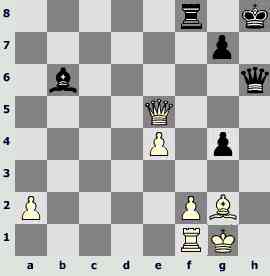
1...?
Veselin Topalov chose 40...Јh4?, and after 41.Јh2 Ґ:f2+ 42.ўh1 Ј:h2+ (42...g5 43.Ј:h4+ gh 44.a4! h3 45.Ґ:h3 gh 46.a5=) 43.ў:h2 g5 (43...¦f6 44.Ґh1) 44.Ґh1! g3+ 45.ўg2 g4 46.¦d1 there arose the ending, though it was a better one for Black, but objectively a drawn one.
Meanwhile the game could have been finished almost in two moves.
40. . . . ¦f8-f4!
Black impedes an exchange of queens and creates a terrible danger 41...g3.
41.Јe5-c3 Јh6-h4°
Fischer – Spassky
4th game of the match, Reykjavik 1972

1...?
White is planning 32.¦f1 or 32.Јc3. 31...Ј:b2?! 32.¦f1 ¦f8 33.c3 bring nothing, with the danger of 34.Јf6+.
There came 31...Ґd6?! 32.Јc3! Ј:c3 33.bc Ґe5inthegame(33...Ґ:a3 34.¦a1) 34.¦d7 ўf6 35.ўg1 Ґ:c3 36.Ґe2 Ґe5 37.ўf1 ¦c8 38.Ґh5 ¦c7 39.¦:c7 Ґ:c7 40.a4 ўe7 41.ўe2 f5 42.ўd3 Ґe5 43.c4 ўd6 44.Ґf7 Ґg3 45.c5+.Adraw.
Having permitted the exchange of queens, Boris Spassky in essence lost his advantage. It's difficult to explain why he went by the strong preventive move:
31. . . . ¦h8-h4!
Thus Black parries both ideas of the opponent and keeps up the dangerous initiative. Forexample: 32.¦f1 (after 32.b3? Ґd6 White has to part with exchange, but 32...g4! is stronger) 32...¦f4 33.Јe2 ¦:f1+ 34.Ј:f1 Ј:b2 (34...Ґd6 35.Јg1 Ј:b2 are also not bad), or 32.Ґe2 ¦f4 33.Јh5 ¦f2.
Karpov – Timman
Mar del Plata 1982
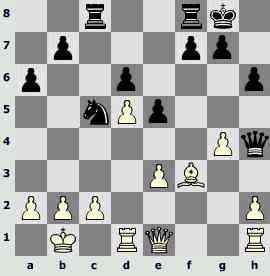
1...?
In case of the exchange on е1 the ending is approximately equal. An unobvious plan of moving the queen to the queen side, where the queen and the knight, as it often happens, will form a powerful tandem is more dangerous for the opponent. Even so skillful defender as Anatoly Karpov did not manage to suppress the rush of Black.
22. . . . Јh4-d8!
23...Јb6 and 24...¤a4 are being planned.
23.e4 Јb6 24.Јe3 Јb5! 25.h4 ¤a4 26.Јb3 ¦c5!. Black prepares thedoubling ofrooks, making use of the fact that in the arisen situation the opponent may not exchange queens.
I will offer you an interesting variant, illustrating the difficulties that White faces: 27.g5!? ¦fc8 28.¦c1 (28.c3 Јa5 29.Ґe2 ¦:c3! 30.bc ¤:c3+ 31.ўa1 ¤:e2 with subsequent ¤d4) 28...Јa5 29.Ґe2 ¦c3! 30.Ј:b7 ¦3c7! (but not 30...Јd8? 31.Јb4!) 31.Јb3 ¤c5 32.Јe3 ¦b8 33.c4 ¦:b2+!! 34.ў:b2 ¦b7+ 35.ўc2 Ј:a2+ 36.ўd1 ¦b3 37.Јd2 ¦b2°.
27.¦h3 ¦fc8 28.c3 (28.¦c1? ¦:c2!) 28...¦8c7 29.ўa1. 29.¦e1 ¤:c3+! 30.bc Јd3+ 31.ўa1 ¦b5 lose immediately. And to 29.¦g3, besides the preventive move 29...g6!, hampering the opening of lines at the king side, there is also an interesting sacrifice of a piece: 29...¤:c3+!? 30.bc Ј:b3+ 31.ab ¦:c3 32.ўb2 ¦e3!.
29...Јd7!.White repulsed the first wave of the attack, that's why Timman turns his attention to the pawn assault of the queen side.
30.Ґe2 b5 31.a3 (31.Јb4 a5! 32.Ј:a5 b4 33.Ј:b4 ¦b7) 31...a5 32.ўb1 ¦b7 33.¦g3 g6!. Timman skillfully combines the attack with the prevention of the opponent's counter actions. He provides safety of his king side by a typical method.
34.g5 h5 35.Ґf1 ¦cc7 36.Јc2 b4 37.ab ab 38.c4 b3!. The pawn is invulnerable (39.¦:b3 ¦:b3 40.Ј:b3 ¤:b2!), therefore the result of the struggle is predetermined.
39.Јg2 ¦b4 (perhaps, 39...Јc8 would be corner-cutting, preparing Јa8 and ¤c5) 40.Јh3 Ј:h3. Not obligatory, but quite possible decision – the attack of Black is strong enough even without queens.
41.¦:h3 ¤c5 42.ўc1 ¤:e4 43.¦e3 ¤c5 44.ўd2 ¤a4 45.¦c1 ¤:b2 46.c5 (46.ўc3 ¤:c4 47.ў:b4 ¤:e3 48.¦:c7 ¤:d5+) 46...¦d4+ 47.ўe2 ¦:c5 48.¦:c5 dc 49.¦:b3 ¤c4 50.¦c3 ¦:h4 51.ўe1, and White resigned.
NEUTRALIZATION OF OPPONENT'S ATTACK
If our king is endangered (even if the danger is potential, latent), then the exchange of the opponent's strongest piece is, as a rule, advantageous for us.
Kasparov – Karpov
13th game of the 2nd match, Moscow 1985
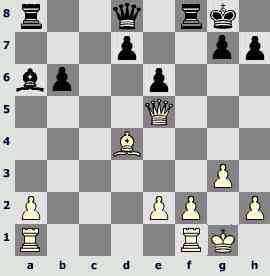
1...?
It's advantageous for Black to exchange queens (thereby attacking the pawn e2) to approach a heaven-sent ending with bishops of opposite colours. In the middlegame on the contrary his position is uneasy because of the presence of the bishops of opposite colours on the board, which, as is well known,strengthen an attack.
18. . . . Јd8-f6!
19.Јe5-e3
To 19.Јd6 there are both 19...Јf7 (with the danger of 20...Ґ:e2), and 19...e5!?
19.... Јf6-h6!
20.Ј:h6 (20.Јe4 d5 21.Јe5 ¦f5) 20...gh 21.¦fe1 Ґc4 22.a3 22.a4 Ґb3 22...b5 23.¦ad1 ¦f5 24.Ґb2 ¦d5. A draw.
Alburt – Roud
Championship of the USA, Estes-Park 1986
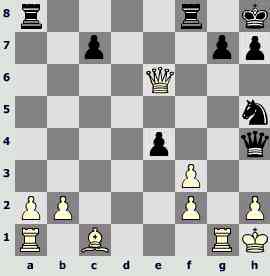
1.?
21.Јe6-g4!ќ
The easiest way to destroy Black's hopes of attack is the exchange of queens. For example: 21...Ј:g4 22.fg ¤f6 23.Ґe3 ¤d5 24.Ґc5ќ.
21...Ј:f2 22.Ј:h5 ef 23.Ґh6! Black resigned.
Korchnoi – Spangenberg
Buenos Aires 1993
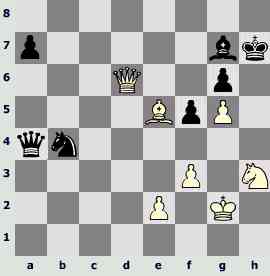
1...?
Black has to reckon with Јe7(c7) or ¤f4. 41...Јb5? 42.Ґ:g7 Ј:e2+ 43.¤f2 ¤c2 (43...ў:g7 44.Ј:b4) 44.Ґd4 ¤e1+ 45.ўh2 ¤:f3+ 46.ўg3ќ doesn't work.
After 41...Ґ:e5?! 42.Ј:e5 Јd7 43.¤f4 the position of Black is still uneasy.
41. . . . Јa4-a6!і
Because of the danger 42...Ј:e2+, Black forces the exchange of queens and thereby eliminates every danger.
42.Ј:a6 ¤:a6 43.Ґd6 Ґc3 44.e4 fe 45.fe Ґb4 46.e5 ўg7 47.ўf3 Ґ:d6 48.ed ¤c5 49.ўe3 ўf7. Adraw.
The following two more complicated examples are taken from my games with the opponents of extra class.
Petrosian – Dvoretsky
Vilnius 1978
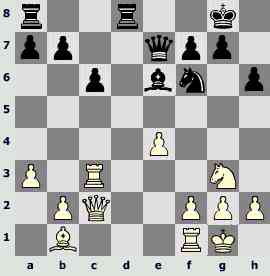
1...?
The danger of е4-е5; to 22...¤d7(h7) or 22...g6 23.f4 is very strong. In order to cushion the attack of White it makes sense to exchange queens.
22. . . . Јe7-d6!
23.f2-f4 Јd6-d4+!
It's important to worsen the position of the white king – weakness of the 1st rank will afterwards help Black.
24.ўg1-h1 Јd4-d2
In the ending White still keeps the initiative, which is not as menacing as at the pawn attack in the middlegame.
25.f5 Ј:c2 26.Ґ:c2 Ґd7 27.e5 ¤g4. I rejected a natural 27...¤d5?! because of 28.¦b3 b6 29.¤h5!. It's not necessary to defend the pawn "b" – there is 28...c5!? (29.¦:b7? ¤e3; 29.¤h5?! Ґa4). Nevertheless, White gets an advantage by means of 29.Ґe4 Ґc6 30.¤h5! ¦e8 (30...¤e7 31.Ґ:c6 ¤:c6 32.e6! fe 33.¦:b7) 31.e6! fe 32.¦g3.
28.¤h5!?. 28.e6 Ґe8! is not clear, but 28.¦e1!? deserved a serious attention, and 28...¦e8 is bad because of 29.e6! fe 30.Ґb3±. It should be met by 28...f6! 29.Ґb3+ ўh7 30.e6 Ґe8 (planning ¦d2; h5), but after 31.¤f1! with subsequent ¤e3 Black had to undertake an unpleasant defence.
28...¤:e5 29.¦g3 ўh8 (29...ўf8 30.¦:g7 are weaker, sinceт 30...Ґe8? 31.f6 and 32.Ґh7 are losing) 30.¦:g7 Ґe8 31.¦g3 (31.f6 ¦d2›) 31...¦d2 32.¤f6 Ґd7, and the game ended in a draw.
For a long while I was sure that the exchange of queens, undertaken by Black, was almost forced, and only recently I've found a worthy alternative to the move 24...Јd2!?. But not 24...Ґg4? 25.e5 Ґd1 26.Јc1 ¤g4 27.h3! (the simplest) 27...¤f2+ 28.ўh2ќ – light pieces of Black stuck in the camp of the opponent, but 24...¤g4!?. The main variant is of interest: 25.e5 (25.f5 Ґd7 leads to ceding of the square e5) 25...ўf8! 26.Јe2!? (if 26.f5 Ґd5 27.e6 countingon27...¤e3?? 28.e7+! ў:e7 29.¦e1ќ, then 27...¦e8!?›) 26...Јd2 27.Ґd3!?(27.Јf3 Ј:b2 is not convincing with the idea 28...¤f2+) 27...Ј:e2 28.Ґ:e2 ¦d2!! (28...h5 29.f5 Ґd5 30.e6 are weaker with he initiative of White) 29.h3 (29.f5 Ґd5 30.Ґ:g4 Ґ:g2+ 31.ўg1 Ґ:f1 32.¤:f1 ¦:b2і) 29...h5!„(to 30.hgcomes 30...h4). However it's hardly possible to find and to calculate exactly this way at the board. The exchange of queens is still simpler and more reliable.
Korchnoi – Dvoretsky
Dutch league, Apeldorn 1999
1.d4 c5 2.d5 e5 3.e4 d6 4.Ґb5+ ¤d7 5.a4 Ґe7 6.f4 ef 7.Ґ:f4 ¤gf6 8.¤c3 0-0 9.¤f3 ¤h5 (9...¤g4!?) 10.Ґd2. To 10.Ґe3 there are both 10...¤df6!? 11.0-0 ¤g4 and 10...Ґf6!? 11.0-0 Јe7.
10...Ґh4+! (a useful intermediate check) 11.g3 Ґf6 12.0-0 g6 13.Ґh6 ¤g7 14.Ґf4 Јe7 15.Јd2 ¤e5 16.Ґ:e5!? Ґ:e5 17.Јh6 f6. As Viktor Korchnoi mentioned after the game, it was possible to play 17...Ґf6!? (with the idea ¤h5, Ґg7), since 18.e5 de 19.d6? Ј:d6 20.¤e4 ¤f5! doesn't work.
17...Ґd4+!? 18.ўg2 ¤h5 were also not bad (with the same idea Ґg7).
18.¤:e5 Ј:e5 (certainly not 18...fe? 19.¦:f8+ Ј:f8 20.Јh4! with subsequent ¦f1) 19.¦f4
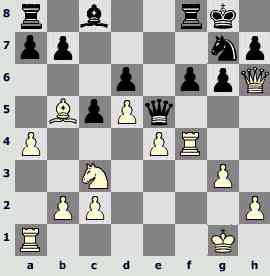
1...?
Being afraid of attack, I forced exchange of queens without long deliberation: 19...Јh5? 20.Ј:h5 ¤:h5. However after 21.¦f2 the ending turned out to be difficult: the opponent quickly creates threats for the queen side and the weak pawn d6. For example, 21...Ґh3 22.a5 a6 (otherwise 23.a6) 23.Ґf1 Ґd7 24.¦a3!, and later ¦b3-b6±, or 21...a6 22.Ґe2 ¤g7 23.a5 Ґd7 24.¦a3! with subsequent ¦b3-b6±.
21...Ґg4?!(in the hope of 22.Ґe2 Ґ:e2 23.¤:e2 ўf7 and 24...ўe7, or 22.¦af1 Ґh3) 22.ўg2! a6 23.h3!, and White has an overwhelming positional advantage. I defended myself stubbornly, at some instant I even got chances to save myself, but nevertheless I lost at the 87th move.
I shouldn't have exchanged the active queen e5, as it was the only piece, which could create counter threats.
19. . . . a7-a6!
Perhaps, the most effective way to parry the threat 20.Јh4 – Black drives away the bishop to get the square е8 for the knight. Less successfully the knight would be placed on h5 in the variants 19...¤h5 20.¦f2 or 19...¦f7 20.¦h4!? ¤h5 (the danger of 21...Јg5) 21.Јe3. It's possible, though rather risky 19...Јd4+!? 20.ўh1 Јd2 (or 20...Јe3!?). To defend himself against 21...¤h5, White plays either 21.¦d1 Ј:c2 22.¦h4 ¤h5 23.Ґe2 Ј:b2 24.Ґ:h5 gh 25.Ј:h5 ¦f7› or 21.Ґe2!?, after what 21...Ј:c2? 22.¦h4 Ј:b2 23.Ј:h7+ ўf7 24.¦f1 Ј:c3 25.¦h6 aren't not advantageous with a very dangerous attack.
20.Ґb5-e2
20.¦h4? didn't work, to which the easiest way to respond is 20...¤h5 21.Ґe2 Јg5!µ.
20. . . . ¦f8-f7
21.¦a1-f1 Ґc8-d7
22.¦f4-h4 ¤g7-e8
23.Ґe2-g4
If 23.a5, then 23...¤c7 and 24...¤b5.
23. . . . Ґd7:g4
24.¦h4:g4 b7-b5!
It's not clear, who has the better position.
